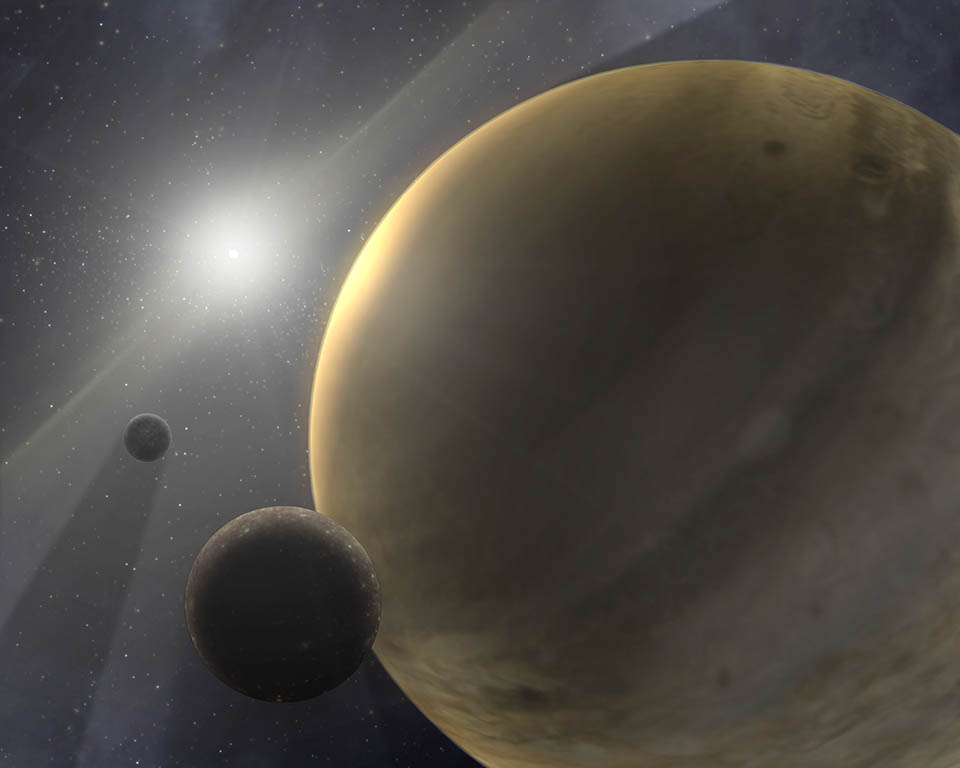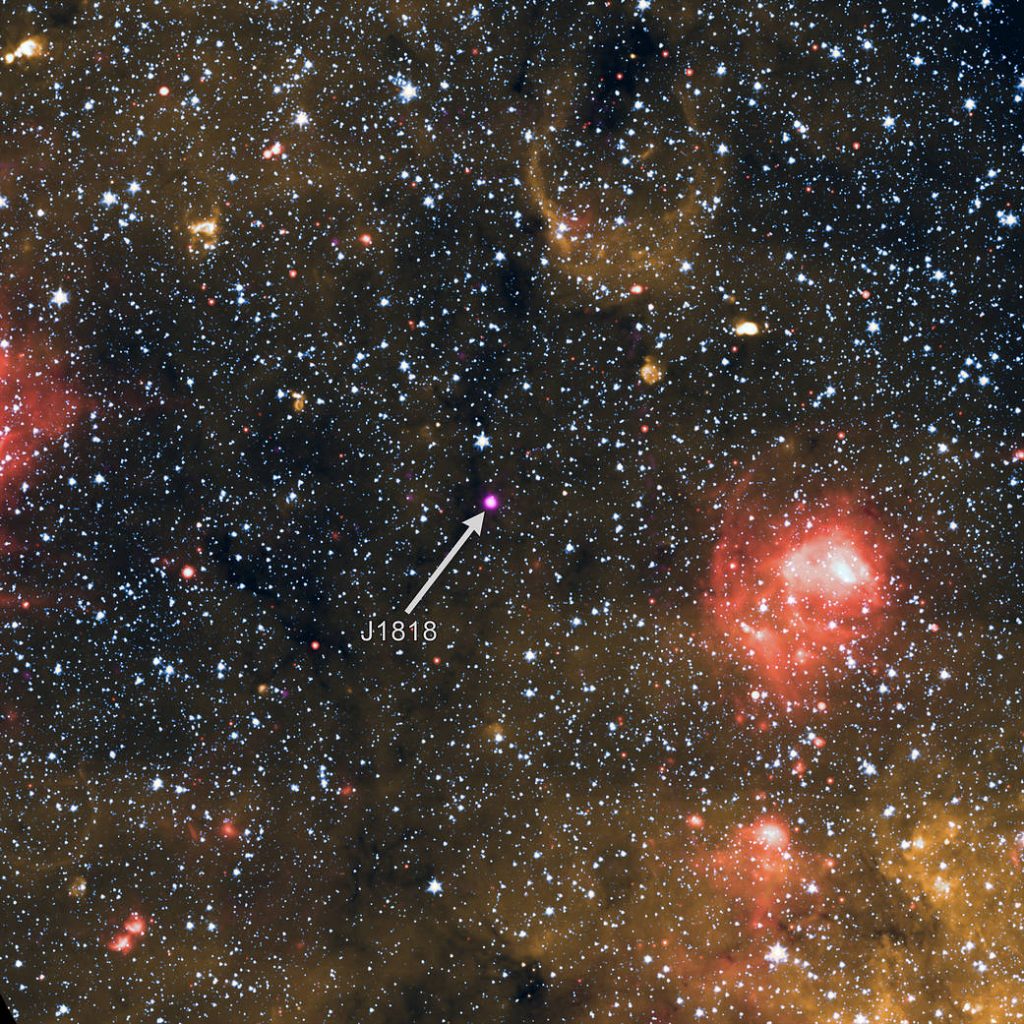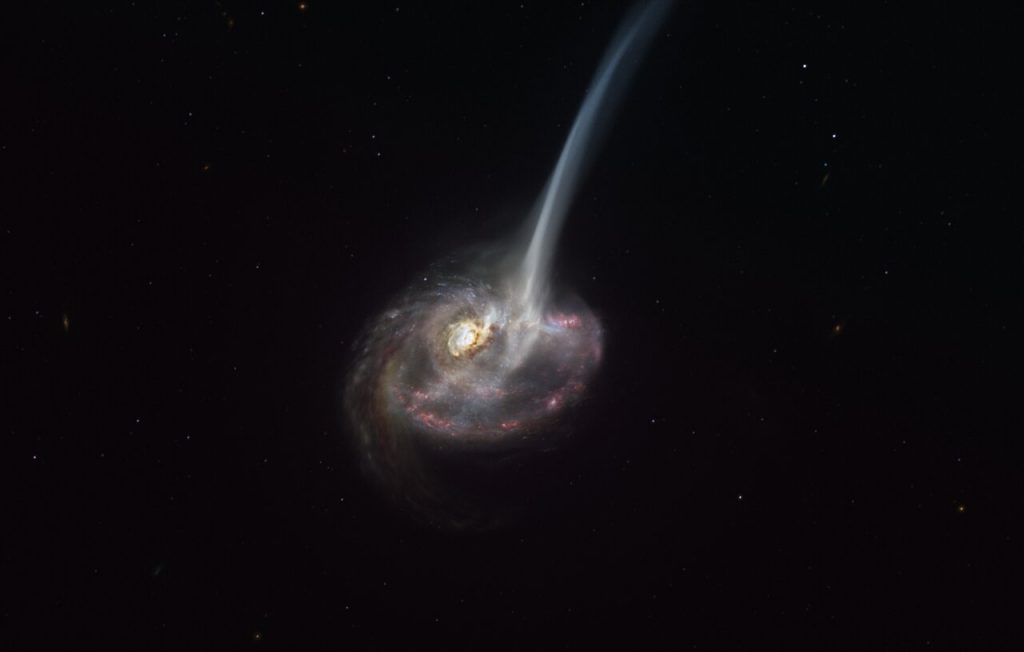Media
Summary
Researchers using NASA’s TESS and the Keck Observatory found a rocky planet orbiting a 10-billion-year-old star in the Milky Way, up in the galaxy’s thick disk. Plus more planetary news from the AAS Winter Meeting, a magnetar, colliding galaxies, and gravitational wave news.
Transcript
This is the Daily Space for today, Tuesday, January 12, 2021. I am your host, Dr. Pamela Gay.
And I am your host, Beth Johnson.
And we are here to put science in your brain.

It’s that time of the year again, and I don’t mean football playoffs. No, I mean the other Super Bowl, although we probably shouldn’t call it that. It’s time for the Super Bowl of Astronomy — the American Astronomical Society winter meeting. Of course, Pamela and I are both wishing we were able to travel and hang out together at the con. This should have been my first year doing Daily Space live from the convention center, trying to find a decent internet connection and making sure we had a green screen on hand.
Instead, I’m at my desk. In my home office. Again. That’s okay, though, because we have all of you in our community, and the AAS meeting is virtual. I actually attended my first side meeting last night, and while it felt like every other meeting I’ve had the last 10 months, what with it being on Zoom, I did meet (so to speak) new people. And yesterday, I got to simulcast my very first official press conference at AAS. Even better, the topic was exoplanets and brown dwarfs, so right up my alley.
This leads me to today’s top story. Researchers using data collected with NASA’s TESS spacecraft and the Keck Observatory in Hawaii have found a rocky planet. That story normally wouldn’t be news, but this planet orbits an extremely old star in our Milky Way that is in what we call the “thick disk”. This means that the star is located within the red-orange oval in the graphic rather than the thin yellow oval where the majority of stars and planets exist.

The stars in the thick disk are unusual. They are far older, on the order of 10 billion years old. They are considered metal-poor, and in this instance, TOI-561 has about 50% the metallicity of our Sun, which used to mean we didn’t expect them to have rocky planets in their orbit. And finally, they have an amazing view of the Milky Way since they out of the majority of the stars and dust, although it’s unlikely anyone is living in the TOI-561 system at this point.
Currently, measurements indicated that this little planet orbits TOI-561 twice for every Earth day and is so close that the surface temperature is over 1700 degrees Celsius (about 3100 degrees Fahrenheit). The planet was found using the transit method, so we had to luck out into the science here a bit, and even with the proper alignment, this planet only caused a 0.025% drop in the star’s brightness as it passed by.
The metal-poor content of the star seems to have led to a lower amount of iron in TOI-561’s rocky world than Earth has, despite the fact that it’s three times the mass. Additionally, it’s not the sole planet in the system. There are two other planets in orbit around TOI-561, both about twice the Earth’s radius but unlikely to be rocky due to their size and mass.
The paper has been accepted for publication in the Astronomical Journal, and lead author Dr. Lauren Weiss sums it up, “The rocky planet orbiting TOI-561 is one of the oldest rocky planets yet discovered. Its existence shows that the universe has been forming rocky planets almost since its inception 14 billion years ago.”
I’m not sure we’ll ever reach a day where we completely understand and can predict how and where planets form. I’m honestly not sure I want to reach that day since the science here continues to be interesting and always shifting a little.
We’ve talked a few times on Daily Space about sub-Neptunes and super-Earths, and Astronomy Cast did an entire episode on them late last year. We don’t have either type of planet in our solar system, obviously, but we keep finding them everywhere else. However, there’s this odd gap in sizing where super-Earths disappear and before sub-Neptunes appear. Astronomers at the University of Hawaiʻi at Mānoa’s Institute for Astronomy decided not to “mind the gap” and went looking for an explanation instead.

It’s hard to study planetary formation and evolution due to the massive time scales needed for observations, so as we did with galaxies last week, researchers here looked at lots of different stars and their planets to get as many snapshots of the process as possible. The study, which was published in the Astronomical Journal, used data from NASA’s Kepler and ESA’s Gaia missions to put together a population of planets. Researchers found that sub-Neptunes gradually lose their atmosphere over billions of years, eventually leading them into super-Earth size. This atmospheric loss is due to intense light from host stars.
Lead author Travis Berger explains: The fact that we see planet sizes change on billion-year timescales suggests that there is an evolutionary pathway, where highly-illuminated sub-Neptune-sized planets transition to becoming super-Earth-sized planets.
Since we first started regularly discovering exoplanets back in 1995, astronomers and planetary scientists have been working to define bigger and better ways to track down every possible world we can see from Earth. From Kepler looking for planets transiting in front of their stars to ground-based surveys looking for the gravitational pushes and pulls of planets on their stars, these surveys have been able to uncover thousands of new worlds.
Beyond providing remarkable science, each of these surveys has offered the astronomical community an opportunity to demonstrate just how ridiculous astronomers can be at naming things. In a new segment we’re calling “Bad Acronyms & Backronyms in Everyday Science”, or “BABIES”, we would like to introduce you to the GOT’EM survey.
GOT’EM stands for “Giant Outer Transiting Exoplanet Mass”. Using the Keck I telescope in Hawaii, this survey is taking repeated observations of stars, looking for the slight to-and-fro motions that would indicate gas giant planets are orbiting in their outer solar systems. Basically, they are looking for solar systems with worlds like our own Jupiter and Neptune.
In their first scientific paper, which is accepted for publication in the Astronomical Journal, they use the survey name in their title and never mention it again. Dear GOT’EM Survey team, this inaugural BABIES award is for you.
If you know of an amazingly ridiculous acronym or backronym worth highlighting, please Tweet it at us: @CosmoQuestX.
[Ed. note: You… you created an acronym to award other acronyms for being bad acronyms. I think you fried my brain a little, but I love it.]

Before we laugh too much, let’s talk about the GOT’EM survey and its first results. Soon to be published in Astronomical Journal, this new paper presents the discovery of a gas giant that orbits very far away from its star. And while the paper may only use the acronym once, the press release uses it a lot. In fact, they refer to this planet as GOT’EM-1b. It’s roughly five times the mass of Jupiter, and it orbits Kepler-1514, about 1300 light-years from Earth.
Most importantly, GOT’EM-1b orbits every 218 days. That’s exciting. As lead author Paul Dalba explains: Taking 218 days to orbit a star is an order of magnitude longer than most giant exoplanets we’ve measured. Kepler discovered thousands of planets, and only a few dozen had orbits of a couple hundred days or longer.
The gas giant exoplanets we have found up until now orbit close to their stars, and many seem to have migrated inward over time. Since this newly discovered gas giant is still far out from its star, we may have found a clue to how our own gas giants have stayed in place. Observing giant planets close to their stars is also difficult because the radiation causes the planet to puff up. GOT’EM-1b doesn’t have that problem, which makes it a prime candidate for follow-up observations by the Roman Space Telescope. We might even be able to find out if it has moons!
Missions like Kepler, CoRot, TESS, and ground-based surveys like GOT’EM are finding planetary candidate after planetary candidate, and each of these potential detections of a world or worlds requires careful follow-up to suss out which worlds are real and which are just starspots or other stellar misbehaviors masquerading as planets.
Scientists are just people, and when we’re faced with stacks of data that needs confirmation, we’re going to generally clean up and publish the nicest looking data first. The super complex stuff… well, sometimes it can get set aside for a while.
In new research presented at the AAS meeting, researchers present a follow-up on KOI-5Ab, the second potential planet discovered by Kepler.

First spotted in 2009, this system clearly had something going on, but exactly what … well the data was a mess, and this object was set aside. By 2014, researchers were able to say, thanks to follow-up observations with the Keck and Gemini North telescopes, that if KOI-5Ab is a planet, it orbits a triple star system. The data was still too messy to confirm a planet, however.
In 2018, the TESS mission just happened to have this weird system in its field of view. With its more sensitive systems, it was able to tease out just what is going on: this system has at least one planet, KOI-5Ab, that is orbiting the largest star in a triple system. This particular system consists of two larger stars, KOI-5A and B, that orbit together like a binary star, and this pair is in turn orbited by a smaller star, KOI-5C. Like nesting wheels, the planet orbits its star roughly every five days, the inner stars orbit one another every thirty years, and the third star orbits the pair every 400 years.
This work was presented by David Ciardi, who admits, KOI-5Ab fell off the table and was forgotten. If it weren’t for TESS looking at the planet again, I would never have gone back and done all this detective work.
This research points out that our powerful suite of space telescopes are returning a wealth of data that over and over again are able to produce new science long beyond the end of their missions. The universe is complicated, and understanding everything we see just takes time.
In astronomy, we periodically have discoveries so amazing that you can remember exactly where you were the moment you learned about them.
Back in 2004, satellites around our planet were blasted with gamma rays so strong that they could pierce through the sides of orbiting observatories and blind detectors. The cause of this burst turned out to be a magnetar. This was the first time I’d heard about these super rare objects.
At the most basic level, magnetars are neutron stars. When some of the larger stars in our universe run out of fuel for fusion in their cores, they collapse down until protons and electrons are no longer able to stay separated. Under the force of gravity, these particles combine, and in a flash of energy and particles, they transform into a dense sphere of neutrons. Only about 3000 neutron stars have so far been discovered, and of these, only 31 have turned out to be magnetars. With each newly found object, magnetars are proving themselves to be even weirder than previously thought.
That thirty-first magnetar was discovered March 12, 2020, by astronomers using the Swift space telescope. It was found thanks to a burst of X-rays it emitted. We discussed this object on our podcast last June. Initially, all we knew was this bursting system is only about 500 years old; It is perhaps the youngest magnetar ever found!

New research coming out in Astrophysical Journal Letters, by Harsha Blumer and Samar Safi-Harb, presents follow-up results that use a myriad of telescopes to peer at this system in just about every kind of light. From radio and infrared observations, they were able to find possible debris from the supernova that created this object, which has the catalog ID J1818.0-1607. If their match is correct, the neutron star is one of the fastest moving ever detected.
In the composite X-ray and infrared image you can see on our website, you can see this pulsar as a pink blob of X-rays. This light isn’t all coming from the tiny 21-mile-across star. What we’re seeing is a small point source surrounded by a diffuse halo of light being scattered by surrounding dust. This is like looking at a flashlight in the fog: the beam is brightest in the center, but the fog creates a diffuse halo. The radio observations also showcased the systematic pulsing of a pulsar that rotates every 1.4 seconds.
Put together, this data shows us that magnetars can be ejected at wild velocities from the supernova they form in and may spin up to fabulous speeds during their collapse, like an ice skater drawing in her arms ever tighter and tighter while rotating. If the theory is correct, humans will be able to watch this young object slow down over time, and track its motion, but that may be research for another generation.
Pulsars — these fast-spinning neutron stars — are essentially rotating tops that have beacons of light that are emitted toward an observer twice per rotation, like the double-sided lights in a lighthouse. Just like a top, pulsars slow down with time, but the deceleration is so slow that, for the most part, we can use the timing of the pulses as a metronome against which we can measure all kinds of phenomena.
Back in 1990, the first exoplanets ever found were discovered orbiting a pulsar, and they were found because the slight orbital motions of the pulsar and the planet going round and round affected the timing of the pulses reaching Earth. I still remember exactly where I was when that discovery was made. I was a high school student working at a spare computer next to a laser printer at Haystack Observatory. It smelled like ozone, and my advisor was super excited to explain pulsar timing to me and why this discovery looked real. Ever since then, I’ve taken delight in all the ways people more creative than I have found to use pulsars to probe what is going on in our galaxy and the universe beyond.
The physics of our universe is weird. As a whole, the universe is expanding thanks to both the residual motion of the Big Bang and the accelerating force of dark energy. When I was little, and I first learned the universe was expanding, I was terrified we were expanding with it, and someday my neurons wouldn’t be able to talk to each other because of the universe’s expansion.
I was a super weird little kid.
But this kind of a “is the solar system expanding? Is the galaxy expanding?” concern is actually pretty common, and for the most part, astronomers brush this question off and say, “No, galaxies and solar systems are gravitationally held together. People and plants and other stuff are chemically held together. The push of the universe’s expansion can’t overcome these forces, so no, if you find yourself expanding, you can’t blame dark energy.”
Occasionally, we find situations where the infall of a galaxy into a cluster is balanced against the expansion of the universe, and we can’t quite tell what that galaxy’s fate may be. On smaller scales, seeing the effects of expansion just hadn’t really been possible.

At least not until a group of astronomers looked carefully at a suite of pulsars positioned around our galaxy. By looking carefully at their timing, researchers can tease out the tiny motions due to the inward acceleration of gravity as these systems orbit the Milky Way and the tiny weird acceleration associated with the expansion of our universe. Since they looked at pulsars at a variety of distances, they can map out the varied distribution of the material in our galaxy and the twisting accelerations that mass’ gravity can create.
This study was presented at the AAS meeting yesterday and was led by Sukanya Chakrabarti. A related paper is appearing in Astrophysical Journal Letters. One of the particularly beautiful things about these results is that it is equally sensitive to mass we can see, like stars and dust, and to the invisible distribution of dark matter, which we have struggled to map out in any detail within our own galaxy.
According to Scott Tremaine: For centuries astronomers have measured the positions and speeds of stars, but these provide only a snapshot of the complex dynamical behavior of the Milky Way galaxy. The accelerations measured by Chakrabarti and her collaborators are directly caused by the gravitational forces from the matter in the galaxy, both visible and dark, and thereby provide a new and promising window on the distribution and the composition of the matter in the galaxy and the universe.
This technique is new, and I am now looking forward to more pulsars allowing more detailed mapping of our universe to take place.
Maybe it’s not the year to talk about the death of a galaxy, but this next story intrigued me. Everything dies apparently, even galaxies. I mean, we talk about the heat death of the universe a lot, but I think this is the first time we’ve taken one step down from that.

In new work presented in Nature Astronomy, researchers used the Atacama Large Millimeter/submillimeter Array (ALMA) to watch a galaxy eject a massive amount of its cold gas content. The galaxy is called ID2299, and it’s about 9 billion light-years away from us, and we’re seeing it when the universe was only 4.5 billion years old. Space-time is mind-boggling at this scale.
Anyway, the gas is being ejected at a rate of 10000 Suns’ worth of mass every year, removing 46% of the total cold gas from the galaxy. And the galaxy is also undergoing extremely fast star formation, and calculations show that it will run out of gas in a few tens of million years. That’s very soon in astronomical terms.
The image we’re sharing is an artist’s impression of the galaxy, and you may notice that one startling feature reaching up away from the galaxy. That’s a tidal tail. They’re usually hard to see; and having tried to tease them out of image data, I can attest to that. I learned to hate a program called IRAF while I was trying. In this instance, though, the tidal tail was a relatively bright feature of the galaxy as it was ejected into space, which made it easy to see and identify.
The other unusual part of this story, in an interesting story all around, is that it seems this galaxy’s death is the result of a galactic merger. Co-author Emanuele Daddi notes: Our study suggests that gas ejections can be produced by mergers and that winds and tidal tails can appear very similar. This might lead us to revise our understanding of how galaxies ‘die’.
Our theme of the universe being weird and expressing its weirdness through pulsars now continues.

A different group of researchers, members of the NANO Grav collaboration, which stands for Nanohertz Observatory for Gravitational Waves, is looking for the ripples that pass through space-time when gravitational waves run through the universe. The kinds of gravitational waves they’re looking for have a much longer wavelength than what can be detected by LIGO and Virgo.
Instead of looking for the distances inside massive Earth-bound detectors to contract, NANO Grav looks for the spaces between us and distant pulsars to contract. If everything works as theorized, distances between us and distant pulsars will contract an amount that is directly related to their distance from us and the direction the waves are traveling. This research was done using a combination of the high accuracy Arecibo Observatory and the large field-of-view Green Bank Telescope.
Unfortunately, while the survey has now published a wealth of preliminary detections, nothing they’re seeing is definitive, and more observations are needed. And Arecibo has collapsed and can’t provide more observations. This research showed us what can be done. It is a hint at the future, but we have to mourn lost potential as we realize what science won’t be possible unless there is an investment in a replacement for Arecibo.
This has been the Daily Space.
Learn More
Rocky Planet Orbiting Iron-Poor, Ancient Milky Way Star
- Keck Observatory press release
- University of Hawai’i press release
- UC Riverside press release
- “The TESS-Keck Survey. II. An Ultra-short-period Rocky Planet and Its Siblings Transiting the Galactic Thick-disk Star TOI-561,” Lauren M. Weiss et al., 2021 January 11, The Astronomical Journal
Sub-Neptune Planets May Shrink to Super-Earth Size
- University of Hawai’i press release
- Institute for Astronomy press release
- “The Gaia–Kepler Stellar Properties Catalog. II. Planet Radius Demographics as a Function of Stellar Mass and Age,” Travis A. Berger et al., 2020 August 12, The Astronomical Journal
Gas Giant Found Orbiting Far From Host Star
- UC Riverside press release
- “Giant Outer Transiting Exoplanet Mass (GOT ‘EM) Survey. I. Confirmation of an Eccentric, Cool Jupiter With an Interior Earth-sized Planet Orbiting Kepler-1514,” Paul A. Dalba et al., to be published in The Astronomical Journal (preprint on arxiv.org)
Forgotten Kepler Planet Candidate Orbits Triple-Star System
Youngest, Fastest Magnetar Studied by Chandra
- NASA press release
- “Chandra observations of the newly discovered magnetar Swift J1818.0-1607,” Harsha Blumer and Samar Safi-Harb, to be published in Astrophysical Journal Letters (preprint on arxiv.org)
Pulsar Acceleration Used to Calculate Milky Way’s Dark Matter Density
- IAS press release
- “A measurement of the Galactic plane mass density from binary pulsar accelerations,” Sukanya Chakrabarti et al., to be published in Astrophysical Journal Letters (preprint on arxiv.org)
ALMA Captures Distant Colliding Galaxy on Verge of ‘Dying’
- ALMA press release
- “A titanic interstellar medium ejection from a massive starburst galaxy at redshift 1.4,” Annagrazia Puglisi et al., 2021 January 11, Nature Astronomy
NANOGrav Project Uses Pulsars to Potentially Detect Gravitational Waves
- CU Boulder press release
- “The NANOGrav 12.5 yr Data Set: Search for an Isotropic Stochastic Gravitational-wave Background,” Zaven Arzoumanian et al., 2020 December 24, The Astrophysical Journal Letters
Credits
Written by Pamela Gay and Beth Johnson
Hosted by Pamela Gay and Beth Johnson
Audio and Video Editing by Ally Pelphrey
Content Editing by Beth Johnson
Intro and Outro music by Kevin MacLeod, https://incompetech.com/music/


 We record most shows live, on Twitch. Follow us today to get alerts when we go live.
We record most shows live, on Twitch. Follow us today to get alerts when we go live.